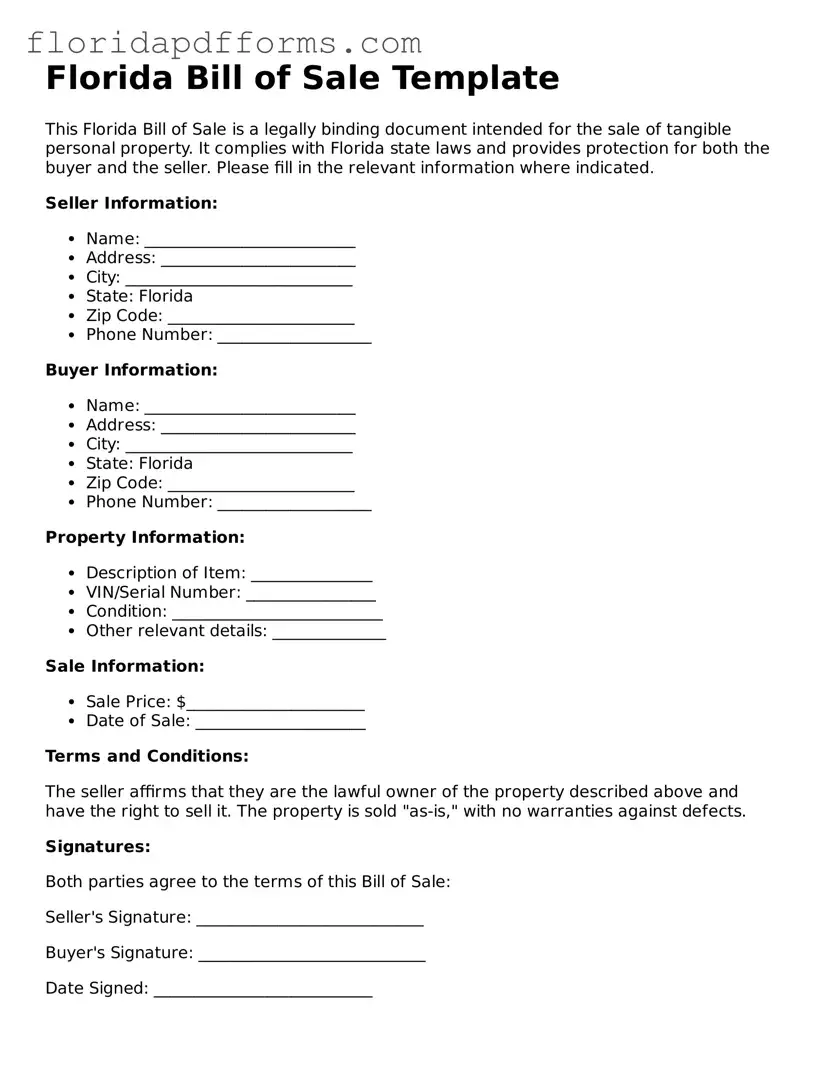The Florida Bill of Sale form is similar to a Vehicle Title Transfer form. Both documents serve as proof of the transfer of ownership for a vehicle. When someone sells a car, the seller must complete the Vehicle Title Transfer form to officially hand over ownership to the buyer. This form usually requires details like the vehicle identification number (VIN), the names of both parties, and the sale price, ensuring that the transaction is recorded properly with the state’s Department of Motor Vehicles.
Another document that shares similarities with the Bill of Sale is the Purchase Agreement. This document outlines the terms of the sale between a buyer and seller, including the price, condition of the item, and any warranties. While a Bill of Sale serves as a receipt confirming the transaction, a Purchase Agreement often includes more detailed terms and conditions, making it a more comprehensive document for larger transactions.
The Lease Agreement is also comparable to the Bill of Sale, particularly in how it outlines the transfer of rights. While a Bill of Sale transfers ownership, a Lease Agreement grants temporary possession of property, such as an apartment or vehicle. Both documents require the signatures of both parties and detail the responsibilities of each party, including payment terms and duration of the agreement.
A Warranty Deed is another document that shares some characteristics with the Bill of Sale. This legal document is used in real estate transactions to transfer property ownership. Like the Bill of Sale, a Warranty Deed includes the names of the parties involved, a description of the property, and guarantees that the seller has the right to sell the property. Both documents serve to protect the interests of the buyer by providing proof of ownership.
The Affidavit of Title can also be compared to the Bill of Sale. This document is used to affirm that the seller has the legal right to sell the property or item in question. In many cases, an Affidavit of Title is used alongside a Bill of Sale to provide additional assurance to the buyer that there are no liens or claims against the property, ensuring a smoother transaction.
In addition, the Assignment of Contract is similar to the Bill of Sale in that it involves the transfer of rights. This document allows one party to transfer their rights and obligations under a contract to another party. While a Bill of Sale is typically used for tangible goods, an Assignment of Contract is often used in business transactions, making it essential for ensuring that all parties are aware of their rights and responsibilities.
The Quitclaim Deed is another document that parallels the Bill of Sale, particularly in real estate. This document is used to transfer interest in a property without guaranteeing that the title is clear. While a Bill of Sale confirms the sale of personal property, a Quitclaim Deed transfers any interest the seller may have in the property, making it a less formal but still significant document in property transactions.
The Receipt for Payment is also akin to the Bill of Sale, as it serves as proof of a transaction. While a Bill of Sale typically details the item sold, a Receipt for Payment may simply confirm that payment has been made for goods or services. Both documents provide evidence of a transaction, which can be important for future reference or disputes.
Lastly, the Promissory Note has some similarities with the Bill of Sale, especially in transactions involving financing. A Promissory Note is a written promise to pay a specified amount of money to a lender. While the Bill of Sale confirms the sale of an item, the Promissory Note outlines the terms under which the buyer agrees to pay for that item, often including interest rates and payment schedules.
